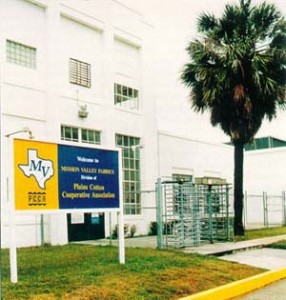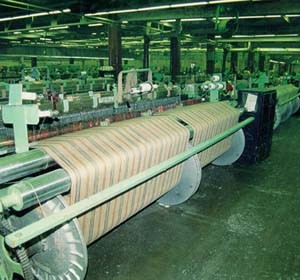By John Johnson

Photo by John Johnson
Dramatic changes in the textile and apparel industries, resulting from international trade agreements, are on the horizon. These changes simultaneously offer opportunity and challenge to U.S. manufacturers who realize they must be more efficient, more flexible, maintain quick response to market conditions, and become more fashion oriented.
Plains Cotton Cooperative Association (PCCA), long known for its innovative developments and utilization of cutting-edge technology, is committed to capitalizing on opportunities and meeting challenges brought on by the changing business environment. The cooperative took an important step toward this commitment in September.
PCCA’s Board of Directors, during its September meeting, approved the first phase of a five-year capital expenditure plan to modernize the Mission Valley Fabrics (MVF) plant at New Braunfels, TX. The $11 million project, which includes replacement of much of MVF’s yarn manufacturing and weaving equipment, began in early November and should be completed by late April 2000 (see related story in this issue).
“We knew at the time we purchased Mission Valley in 1998 that some of the plant’s equipment would have to be upgraded,” explains Van May, PCCA president and CEO. “Intense competition from imports of cheap Asian textile and apparel goods during the past 12 to 18 months and changes about to occur due to international trade agreements have accelerated the need to modernize Mission Valley,” he adds.
The first of several important changes in textile and apparel trade will become evident on January 1, 2000, when yarn-dyed, cotton-rich fabrics such as those made at MVF become tariff free under provisions of the North American Free Trade Agreement (NAFTA). The agreement, which became effective in 1994, requires quota free and duty (tariff) free trade between the United States, Mexico and Canada to be phased in during a 10-year period.
“This means much of the fabric we make at Mission Valley can be shipped to cut-and-sew operations in Mexico free of quotas and tariffs,” May explains, “and that could boost our sales to customers who must rely on lower labor costs in Mexico.” Likewise, imports of Mexican apparel made from Mexican fabric into the United States also become quota and duty free on January 1.

The modernization project will replace 202 Sulzer looms manufactured between 1975 and 1982 with 77 new, high-speed looms. Photo by John Johnson
“Implementation of this phase of NAFTA is like a two-sided coin,” says May. “On one side is the opportunity for PCCA to increase its sales of raw cotton to Mexican mills and MVF products to apparel customers. On the flip side of the coin is the potential for increased competition with imported Mexican yarn-dyed, woven fabrics in the U.S. market.” Other trade agreements also were factors in PCCA’s decision to modernize the Mission Valley plant.
Significant sales opportunities will exist for U.S. textile manufacturers if and when Congress extends NAFTA parity to other countries in the Caribbean and portions of Latin America through legislation commonly referred to as the Caribbean Basin Initiative. Such opportunity is contingent upon retention of “rules of origin” originally contained in NAFTA. In other words, fabric or apparel imported from the Caribbean must contain yarn or fabric made in the United States.
Another factor will become reality in 2005, the deadline for members of the World Trade Organization (WTO) to have eliminated quotas and harmonized tariffs. Most countries have agreed to actually reduce tariffs by the 2005 deadline. At present, China (see related story on page 9) and Taiwan are not members of the WTO, but a number of other textile and apparel manufacturing countries are waiting anxiously for 2005 to arrive to gain greater access to the U.S. consumer market.
“We must invest in Mission Valley to achieve greater flexibility,” May continues. “We also must have a volume-oriented sales strategy to drive down the per-yard fixed costs and be price competitive,” he says, “and we must maximize efficiency to cut our labor costs. At the same time, we must continue to develop apparel relationships in Mexico and the Caribbean.”
Never content to rest on past laurels or maintain the status quo, PCCA continues to forge ahead in its efforts to add significant value to the cotton marketed for its members. It is a philosophy that has successfully served the cooperative’s members for many years.


